Model Study of the Effects of Climate Change on the Methane Emissions on the Arctic Shelves
Abstract
1. Introduction
2. Materials and Methods
2.1. Coupled Ice–Ocean Model
2.2. Tracer Model
2.3. Spatial Distributions of Submarine Permafrost and Model Sources of Methane
3. Results
3.1. Sea Ice State from Model Simulations
3.2. Sea Surface Warming in the Arctic Shelf Seas
3.3. Dissolved Methane Concentration in Water
3.4. Methane Emissions Rates
3.5. Estimates of the Annual Methane Emissions
3.6. Fraction of CH4 That Reaches the Air–Water Interface
4. Discussion
- -
- To assess the fate of methane, which came from bottom sediments into the water column;
- -
- To estimate the amount of CH4 that can reach the atmosphere;
- -
- To see the role of the ocean and sea ice in this process;
- -
- To assess the impact of climatic changes, namely, the reduction in the ice cover, surface water temperature increasing, and wind intensification in recent decades.
5. Conclusions
- -
- To obtain a model estimate of methane emissions from the seas of the Arctic shelf into the atmosphere due to an increase in the permeability of frozen bottom sediments based on the ice-ocean model.
- -
- To understand the relationship between spatio-temporal methane emissions and ongoing changes in the ocean and ice.
Author Contributions
Funding
Institutional Review Board Statement
Informed Consent Statement
Data Availability Statement
Acknowledgments
Conflicts of Interest
References
- Kwok, R.; Cunningham, G.F.; Wensnahan, M.; Rigor, I.; Zwally, H.J.; Yi, D. Thinning and volume loss of the Arctic Ocean sea ice cover: 2003–2008. J. Geophys. Res. 2009, 114, C07005. [Google Scholar] [CrossRef]
- Comiso, J.J. Large decadal decline of the arctic multiyear ice cover. J. Clim. 2012, 25, 1176–1193. [Google Scholar] [CrossRef]
- Collins, M.; Sutherland, M.; Bouwer, L.; Cheong, S.-M.; Frölicher, T.; Jacot Des Combes, H.; Koll Roxy, M.; Losada, I.; McInnes, K.; Ratter, B.; et al. 2019: Extremes, Abrupt Changes and Managing Risk. In IPCC Special Report on the Ocean and Cryosphere in a Changing Climate; Pörtner, H.-O., Roberts, D.C., Masson-Delmotte, V., Zhai, P., Tignor, M., Poloczanska, E., Mintenbeck, K., Alegría, A., Nicolai, M., Okem, A., et al., Eds.; Intergovernmental Panel on Climate Change: Geneva, Switzerland, 2019; Available online: https://www.ipcc.ch/report/srocc/ (accessed on 25 October 2021).
- Yulin, A.V.; Vyazigina, N.A.; Egorova, E.S. Interannual and seasonal variability of Arctic Sea ice extent according to satellite observations. Russ. Arct. 2019, 7, 26–35. (In Russian) [Google Scholar]
- Review of Hydrometeorological Processes in the Arctic Ocean. 2015–2020. (In Russian). Available online: http://www.aari.ru/main.php?lg=0&id=449 (accessed on 25 October 2021).
- Döscher, R.; Vihma, T.; Maksimovich, E. Recent advances in understanding the Arctic climate system state and change from a sea ice perspective: A review. Atmos. Chem. Phys. 2014, 14, 13571–13600. [Google Scholar] [CrossRef]
- Singh, R.K.; Maheshwari, M.; Oza, S.R.; Kumar, R. Long-term variability in Arctic Sea surface temperatures. Polar Sci. 2013, 7, 233–240. [Google Scholar] [CrossRef][Green Version]
- Timmermans, M.-L.; Labe, Z. Sea Surface Temperature; Arctic Report Card, Update to 2020; National Oceanic and Atmospheric Administration (NOAA): Washington, DC, USA, 2020; pp. 54–58. [CrossRef]
- Hu, S.; Zhang, L.; Qian, S. Marine heatwaves in the Arctic region: Variation in different ice covers. Geophys. Res. Lett. 2020, 47, e2020GL089329. [Google Scholar] [CrossRef]
- Reynolds, R.W.; Smith, T.M.; Liu, C.; Chelton, D.B.; Casey, K.S.; Schlax, M.G. Daily High-Resolution-Blended Analyses for Sea Surface Temperature. J. Clim. 2007, 20, 5473–5496. [Google Scholar] [CrossRef]
- Golubeva, E.; Kraineva, M.; Platov, G.; Iakshina, D.; Tarkhanova, M. Marine Heatwaves in Siberian Arctic Seas and Adjacent Region. Remote Sens. 2021, 13, 4436. [Google Scholar] [CrossRef]
- Romanovskii, N.N.; Hubberten, H.W.; Gavrilov, A.V.; Eliseeva, A.A.; Tipenko, G.S. Offshore permafrost and gas hydrate stability zone on the shelf of East Siberian Seas. Geo-Mar. Lett. 2005, 25, 167–182. [Google Scholar] [CrossRef]
- Ruppel, C. Permafrost-associated gas hydrate: Is it really approximately 1 % of the global system? J. Chem. Eng. Data 2015, 60, 429–436. [Google Scholar] [CrossRef]
- Malakhova, V.V. The response of the Arctic Ocean gas hydrate associated with subsea permafrost to natural and anthropogenic climate changes. IOP Conf. Ser. Earth Environ. Sci. 2020, 606, 012035. [Google Scholar] [CrossRef]
- Kirschke, S.; Bousquet, P.; Ciais, P.; Saunois, M.; Canadell, J.G.; Dlugokencky, E.J.; Bergamaschi, P.; Bergmann, D.; Blake, D.R.; Bruhwiler, L. Three decades of global methane sources and sinks. Nat. Geosci. 2013, 6, 813–823. [Google Scholar] [CrossRef]
- James, R.; Bousquet, P.; Bussmann, I.; Haeckel, M.; Kipfer, R.; Leifer, I.; Niemann, H.; Ostrovsky, I.; Piskozub, J.; Rehder, G.; et al. Effects of climate change on methane emissions from seafloor sediments in the Arctic Ocean: A review. Limnol. Oceanogr. 2016, 61, S283–S299. [Google Scholar] [CrossRef]
- Malakhova, V.; Eliseev, A. Uncertainty in temperature and sea level datasets for the Pleistocene glacial cycles: Implications for thermal state of the subsea sediments. Glob. Planet. Change 2020, 192, 103249. [Google Scholar] [CrossRef]
- Overduin, P.P.; Schneider von Deimling, T.; Miesner, F.; Grigoriev, M.N.; Ruppel, C.D.; Vasiliev, A.; Lantuit, H.; Juhls, B.; Westermann, S. Submarine permafrost map in the Arctic modeled using 1-D transient heat flux (SuPerMAP). J. Geophys. Res. Oceans 2019, 124, 3490–3507. [Google Scholar] [CrossRef]
- Malakhova, V.V. Estimation of the subsea permafrost thickness in the Arctic Shelf. In Proceedings of the 24th International Symposium on Atmospheric and Ocean Optics: Atmospheric Physics, Tomsk, Russia, 2–5 July 2018; SPIE: Bellingham, WA, USA, 2018; Volume 10833. [Google Scholar] [CrossRef]
- Gavrilov, A.; Malakhova, V.; Pizhankova, E.; Popova, A. Permafrost and Gas Hydrate Stability Zone of the Glacial Part of the East-Siberian Shelf. Geosciences 2020, 10, 484. [Google Scholar] [CrossRef]
- Angelopoulos, M.; Overduin, P.; Jenrich, M.; Nitze, I.; Günther, F.; Strauss, J.; Westermann, S.; Schirrmeister, L.; Kholodov, A.; Krautblatter, M.; et al. Onshore thermokarst primes subsea permafrost degradation. Geophys. Res. Lett. 2021, 48, e2021GL093881. [Google Scholar] [CrossRef]
- Schuur, E.; McGuire, A.; Schädel, C.; Grosse, G.; Harden, J.W.; Hayes, D.J.; Hugelius, G.; Koven, C.D.; Kuhry, P.; Lawrence, D.M.; et al. Climate change and the permafrost carbon feedback. Nature 2015, 520, 171–179. [Google Scholar] [CrossRef]
- Sayedi, S.S.; Abbott, B.W.; Thornton, B.F.; Frederick, J.M.; Vonk, J.E.; Overduin, P.; Schädel, C.; Schuur, E.A.G.; Bourbonnais, A.; Demidov, N.; et al. Subsea permafrost carbon stocks and climate change sensitivity estimated by expert assessment. Environ. Res. Lett. 2020, 15, 124075. [Google Scholar] [CrossRef]
- Dmitrenko, I.; Kirillov, S.; Tremblay, L.; Kassens, H.; Anisimov, O.; Lavrov, S.; Razumov, S.; Grigoriev, M. Recent changes in shelf hydrography in the Siberian Arctic: Potential for subsea permafrost instability. J. Geophys. Res. Oceans 2011, 116, C10027. [Google Scholar] [CrossRef]
- Kvenvolden, K.A.; Lilley, M.D.; Lorenson, T.D.; Barnes, P.W.; McLaughlin, E. The Beaufort Sea continental shelf as a seasonal source of atmospheric methane. Geophys. Res. Lett. 1993, 20, 2459–2462. [Google Scholar] [CrossRef]
- Ruppel, C.D.; Kessler, J.D. The interaction of climate change and methane hydrates. Rev. Geophys. 2017, 55, 126–168. [Google Scholar] [CrossRef]
- Mestdagh, T.; Poort, J.; De Batist, M. The sensitivity of gas hydrate reservoirs to climate change: Perspectives from a new combined model for permafrost-related and marine settings. Earth Sci. Rev. 2017, 169, 104–131. [Google Scholar] [CrossRef]
- Majorowicz, J.A.; Safanda, J.; Osadetz, K. Inferred gas hydrate and permafrost stability history models linked to climate change in the Beaufort-Mackenzie Basin, Arctic Canada. Clim. Past 2012, 8, 667–682. [Google Scholar] [CrossRef]
- Shakhova, N.E.; Semiletov, I.P.; Leifer, I.; Sergienko, V.; Salyuk, A.; Kosmach, D.; Chernykh, D.; Stubbs, C.; Nicolsky, D.; Tumskoy, V.; et al. Ebullition and storm-induced methane release from the East Siberian Arctic Shelf. Nat. Geosci. 2014, 7, 64–70. [Google Scholar] [CrossRef]
- Shakhova, N.E.; Semiletov, I.P.; Salyuk, A.; Yusupov, V.; Kosmach, D.; Gustafsson, O. Extensive Methane Venting to the Atmosphere from Sediments of the East Siberian Arctic Shelf. Science 2010, 327, 1246–1250. [Google Scholar] [CrossRef]
- Pankratova, N.; Skorokhod, A.; Belikov, I.; Elansky, N.; Rakitin, V.; Shtabkin, Y.; Berezina, E. Evidence of atmospheric response to methane emissions from the East Siberian Arctic Shelf. Geogr. Environ. Sustain. 2018, 11, 85–92. [Google Scholar] [CrossRef]
- Malakhova, V.; Golubeva, E. Estimation of the permafrost stability on the East Arctic shelf under the extreme climate warming scenario for the XXI century. Ice Snow 2016, 56, 61–72. [Google Scholar] [CrossRef]
- Frederick, J.M.; Buffett, B.A. Taliks in relic submarine permafrost and methane hydrate deposits: Pathways for gas escape under present and future conditions. J. Geophys. Res. Earth 2014, 119, 106–122. [Google Scholar] [CrossRef]
- Thornton, B.F.; Geibel, M.C.; Crill, P.M.; Humborg, C.; Mörth, C.-M. Methane fluxes from the sea to the atmosphere across the Siberian shelf seas. Geophys. Res. Lett. 2016, 43, 5869–5877. [Google Scholar] [CrossRef]
- Thornton, B.F.; Prytherch, J.; Andersson, K.; Brooks, I.M.; Salisbury, D.; Tjernström, M.; Crill, P.M. Shipborne eddy covariance observations of methane fluxes constrain Arctic Sea emissions. Sci. Adv. 2020, 6, eaay7934. [Google Scholar] [CrossRef] [PubMed]
- Tohjima, Y.; Zeng, J.; Shirai, T.; Niwa, Y.; Ishidoya, S.; Taketani, F.; Sasano, D.; Kosugi, N.; Kameyama, S.; Takashima, H.; et al. Estimation of CH4 emissions from the East Siberian Arctic Shelf based on atmospheric observations aboard the R/V Mirai during fall cruises from 2012 to 2017. Polar Sci. 2020, 27, 100571. [Google Scholar] [CrossRef]
- Fenwick, L.; Capelle, D.; Damm, E.; Zimmermann, S.; Williams, W.J.; Vagle, S.; Tortell, P.D. Methane and nitrous oxide distributions across the North American Arctic Ocean during summer, 2015. J. Geophys. Res. Oceans 2017, 122, 390–412. [Google Scholar] [CrossRef]
- Berchet, A.; Bousquet, P.; Pison, I.; Locatelli, R.; Chevallier, F.; Paris, J.-D.; Dlugokencky, E.J.; Laurila, T.; Hatakka, J.; Viisanen, Y.; et al. Atmospheric constraints on the methane emissions from the East Siberian shelf. Atmos. Chem. Phys. 2016, 16, 4147–4157. [Google Scholar] [CrossRef]
- Bussmann, I.; Hackbusch, S.; Schaal, P.; Wichels, A. Methane distribution and oxidation around the Lena Delta in summer 2013. Biogeosciences 2017, 14, 4985–5002. [Google Scholar] [CrossRef]
- Canadell, J.; Monteiro, P.; Costa, M.; Cotrim da Cunha, L.; Cox, P.; Eliseev, A.; Henson, S.; Ishii, M.; Jaccard, S.; Koven, C.; et al. Global carbon and other biogeochemical cycles and 400 feedbacks. In Climate Change 2021: The Physical Science Basis. Contribution of Working Group I to the Sixth Assessment Report of the Intergovernmental Panel on Climate Change; Masson-Delmotte, V., Zhai, P., Pirani, A., Connors, S., Péan, C., Berger, S., Caud, N., Chen, Y., Goldfarb, L., Gomis, M., et al., Eds.; Cambridge University Press: Cambridge, UK; New York, NY, USA, 2021. [Google Scholar]
- Malakhova, V.V.; Golubeva, E.N. On possible methane emissions from the East Arctic Sea. Atmos Ocean. Opt. 2013, 26, 452–458. (In Russian) [Google Scholar]
- Wåhlström, I.; Meier, H.E.M. A model sensitivity study for the sea-air exchange of methane in the Laptev Sea, Arctic Ocean. Tellus Ser. B Chem. Phys. Meteorol. 2014, 66, 24174. [Google Scholar] [CrossRef]
- Golubeva, E.N.; Platov, G.A. Numerical modeling of the Arctic Ocean Ice System Response to Variations in the Atmospheric Circulation from 1948 to 2007. Izv. Atmos. Ocean. Phys. 2009, 45, 137–151. [Google Scholar] [CrossRef]
- Platov, G.A.; Golubeva, E.N.; Kraineva, M.V.; Malakhova, V.V. Modeling of climate tendencies in Arctic seas based on atmospheric forcing EOF decomposition. Ocean. Dyn. 2019, 69, 747–767. [Google Scholar] [CrossRef]
- Golubeva, E.; Platov, G.; Malakhova, V.; Kraineva, M.; Iakshina, D. Modelling the Long-Term and Inter-Annual Variability in the Laptev Sea Hydrography and Subsea Permafrost State. Polarforschung 2017, 87, 195–210. [Google Scholar] [CrossRef]
- Golubeva, E.N.; Ivanov, J.A.; Kuzin, V.I.; Platov, G.A. Numerical modeling of the World Ocean circulation including upper ocean mixed layer. Oceanol. Engl. Transl. 1992, 32, 395–405. [Google Scholar]
- Iakshina, D.F.; Golubeva, E.N. Influence of the vertical mixing parameterization on the modeling results of the Arctic Ocean hydrology. Proc. SPIE 2017, 10466, 1046657. [Google Scholar] [CrossRef]
- Iakshina, D.F.; Golubeva, E.N. Sensitivity study of a warm Atlantic layer to diffusion parametrization in the Arctic modeling. Bull. Nov. Comp. Center 2014, 14, 1–15. [Google Scholar]
- Platov, G.A. Numerical modeling of the Arctic Ocean deepwater formation: Part II. Results of regional and global experiments. Izv. Atmos. Ocean. Phys. 2011, 47, 377–392. [Google Scholar] [CrossRef]
- Burchard, H.; Bolding, K.; Villarreal, M.R. GOTM, a General Ocean Turbulence Model: Theory, Implementation and Test Cases. Tech. Rep. EUR 18745,103, EN; European Commission: Brussels, Belgium, 1999; Available online: https://gotm.net (accessed on 8 December 2021).
- Hunke, E.C.; Dukowicz, J.K. An elastic-viscous-plastic model for ice dynamics. J. Phys. Oceanogr. 1997, 27, 1849–1867. [Google Scholar] [CrossRef]
- Bitz, C.M.; Lipscomb, W.H. An energy-conserving thermodynamic model of sea ice. J. Geophys. Res. 1999, 104, 15669–15677. [Google Scholar] [CrossRef]
- Lipscomb, W.H.; Hunke, E.C. Modeling Sea Ice Transport Using Incremental Remapping. Mon. Weather Rev. 2004, 132, 1341–1354. [Google Scholar] [CrossRef]
- Zakharov, V.F. The role of flaw leads off the edge of fast ice in the hydrological and ice regime of the Laptev Sea. Oceanol. Engl. Transl. 1966, 6, 815–821. [Google Scholar]
- Woodgate, R.A. Increases in the Pacific inflow to the Arctic from 1990 to 2015, and insights into seasonal trends and driving mechanisms from year-round Bering Strait mooring data. Prog. Oceanogr. 2018, 160, 124–154. [Google Scholar] [CrossRef]
- Kalnay, E.; Kanamitsu, M.; Kistler, R.; Collins, W.; Deaven, D.; Gandin, L.; Iredell, M.; Saha, S.; White, G.; Woollen, J.; et al. The NCEP/NCAR 40-Year Reanalysis Project. Bull. Amer. Meteor. Soc. 1996, 77, 437–471. [Google Scholar] [CrossRef]
- Steele, M.; Morley, R.; Ermold, W. PHC: A global hydrography with a high quality Arctic Ocean. J. Clim. 2000, 14, 2079–2087. [Google Scholar] [CrossRef]
- Mau, S.; Gentz, T.; Körber, J.-H.; Torres, M.E.; Römer, M.; Sahling, H.; Wintersteller, P.; Martinez, R.; Schlüter, M.; Helmke, E. Seasonal methane accumulation and release from a gas emission site in the central North Sea. Biogeosciences 2015, 12, 5261–5276. [Google Scholar] [CrossRef]
- Mau, S.; Blees, J.; Helmke, E.; Niemann, H.; Damm, E. Vertical distribution of methane oxidation and methanotrophic response to elevated methane concentrations in stratified waters of the Arctic fjord Storfjorden (Svalbard, Norway). Biogeosciences 2013, 10, 6267–6278. [Google Scholar] [CrossRef]
- Wanninkhof, R.; Asher, W.E.; Ho, D.T.; Sweeney, C.; McGillis, W.R. Advances in quantifying air-sea gas exchange and environmental forcing. Ann. Rev. Mar. Sci. 2009, 1, 213–244. [Google Scholar] [CrossRef]
- Wanninkhof, R. Relationship between wind speed and gas exchange over the ocean revisited. Limnol. Oceanogr. Meth. 2014, 12, 351–362. [Google Scholar] [CrossRef]
- Wiesenburg, D.A.; Guinasso, N.L., Jr. Equilibrium solubilities of methane, carbon monoxide, and hydrogen in water and sea water. J. Chem. Eng. Data 1979, 24, 356–360. [Google Scholar] [CrossRef]
- Shakhova, N.; Semiletov, I.; Sergienko, V.; Lobkovsky, L.; Yusupov, V.; Salyuk, A.; Salomatin, A.; Chernykh, D.; Kosmach, D.; Panteleev, G.; et al. The East Siberian Arctic Shelf: Towards further assessment of permafrost-related methane fluxes and role of sea ice. Philos. Trans. R. Soc. A 2015, 373, 20140451. [Google Scholar] [CrossRef] [PubMed]
- Golubeva, E.; Kraineva, M.; Platov, G. Simulation of near-bottom water warming in the Laptev Sea. IOP Conf. Ser. Earth Environ. Sci. 2020, 611, 012010. [Google Scholar] [CrossRef]
- National Snow and Ice Data Center: Sea Ice Index. Available online: https://nsidc.org/data/seaice_index/archives (accessed on 20 June 2021).
- Damm, E.; Bauch, D.; Krumpen, T.; Rabe, B.; Korhonen, M.; Vinogradova, E.; Uhlig, C. The Transpolar Drift conveys methane from the Siberian Shelf to the central Arctic Ocean. Sci. Rep. 2018, 8, 4515. [Google Scholar] [CrossRef] [PubMed]
- Proshutinsky, A.; Steele, M.; Timmermans, M.-L. Forum for Arctic Modeling and Observational Synthesis (FAMOS): Past, current, and future activities. J. Geophys. Res. Ocean. 2016, 121, 3803–3819. [Google Scholar] [CrossRef]
- Timmermans, M.-L.; Proshutinsky, A.; Golubeva, E.; Jackson, J.M.; Krishfield, R.; McCall, M.; Platov, G.; Toole, J.; Williams, W.; Kikuchi, T.; et al. Mechanisms of Pacific summer water variability in the Arctic’s Central Canada Basin. J. Geophys. Res. Ocean. 2014, 119, 7523–7548. [Google Scholar] [CrossRef]
- Proshutinsky, A.; Krishfield, R.; Toole, J.M.; Timmermans, M.-L.; Williams, W.; Zimmermann, S.; Yamamoto-Kawai, M.; Armitage, T.W.K.; Dukhovskoy, D.; Golubeva, E.; et al. Analysis of the Beaufort Gyre freshwater content in 2003–2018. J. Geophys. Res. Oceans 2019, 124, 9658–9689. [Google Scholar] [CrossRef] [PubMed]
- Aksenov, Y.; Karcher, M.; Proshutinsky, A.; Gerdes, R.; de Cuevas, B.; Golubeva, E.; Kauker, F.; Nguyen, A.T.; Platov, G.A.; Wadley, M.; et al. Arctic pathways of Pacific Water: Arctic Ocean Model Intercomparison experiments. J. Geophys. Res. Oceans 2016, 121, 27–59. [Google Scholar] [CrossRef]
- Hobday, A.J.; Alexander, L.V.; Perkins, S.E.; Smale, D.A.; Straub, S.C.; Oliver, E.C.J.; Benthuysen, J.A.; Burrows, M.T.; Donat, M.G.; Feng, M.; et al. A hierarchical approach to defining marine heatwaves. Prog. Oceanogr. 2016, 141, 227–238. [Google Scholar] [CrossRef]
- Yurganov, L.N. The relationship between methane transport to the atmosphere and the decay of the Kara Sea ice cover: Satellite data for 2003–2019. Ice Snow 2020, 60, 423–430. [Google Scholar] [CrossRef]
- Wilkenskjeld, S.; Miesner, F.; Overduin, P.; Puglini, M.; Brovkin, V. Strong increase of thawing of subsea permafrost in the 22nd century caused by anthropogenic climate change. Cryosphere Discuss. 2021, 2021, 1–18. [Google Scholar] [CrossRef]
- Baranov, B.; Galkin, S.; Vedenin, A.; Vedenin, A.; Dozorova, K.; Gebruk, A.; Flint, M. Methane seeps on the outer shelf of the Laptev Sea: Characteristic features, structural control, and benthic fauna. Geo. Mar. Lett. 2020, 40, 541–557. [Google Scholar] [CrossRef]
- Winkel, M.; Mitzscherling, J.; Overduin, P.P.; Horn, F.; Winterfeld, M.; Rijkers, R.; Grigoriev, M.N.; Knoblauch, C.; Mangelsdorf, K.; Wagner, D.; et al. Anaerobic methanotrophic communities thrive in deep submarine permafrost. Sci. Rep. 2018, 8, 1291. [Google Scholar] [CrossRef] [PubMed]
- Leifer, I.; Luyendyk, B.P.; Boles, J.; Clark, J.F. Natural marine seepage blowout: Contribution to atmospheric methane. Glob. Biogeochem. Cycles 2006, 20, GB3008. [Google Scholar] [CrossRef]
- Lorenson, T.D.; Kvenvolden, K.A. Methane in Coastal Water, Sea Ice, and Bottom Sediments, Beaufort Sea, Alaska; Open-File Report 95–70; U.S. Department of the Interior, U.S. Geological Survey: Menlo Park, CA, USA, 1995.

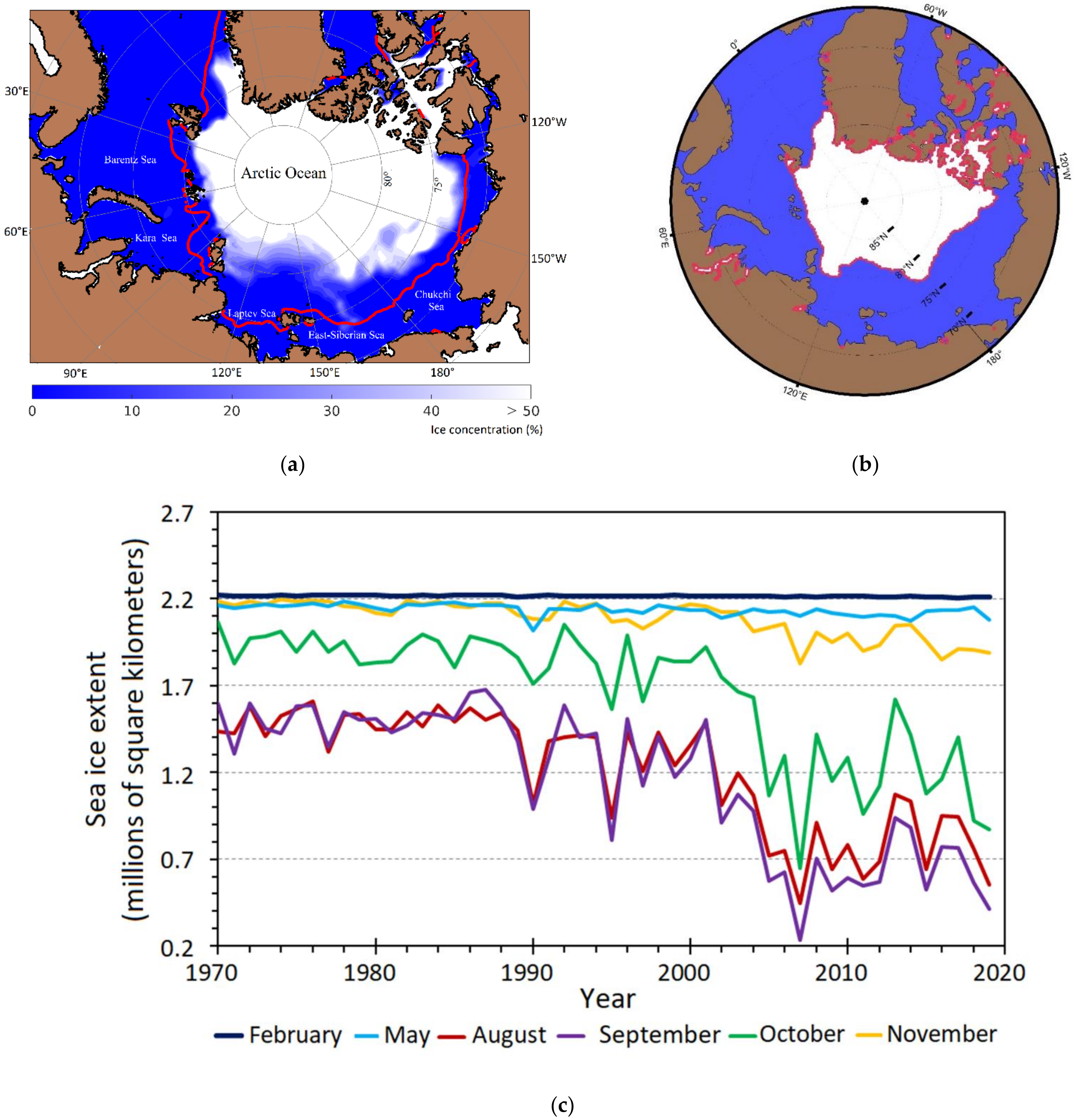
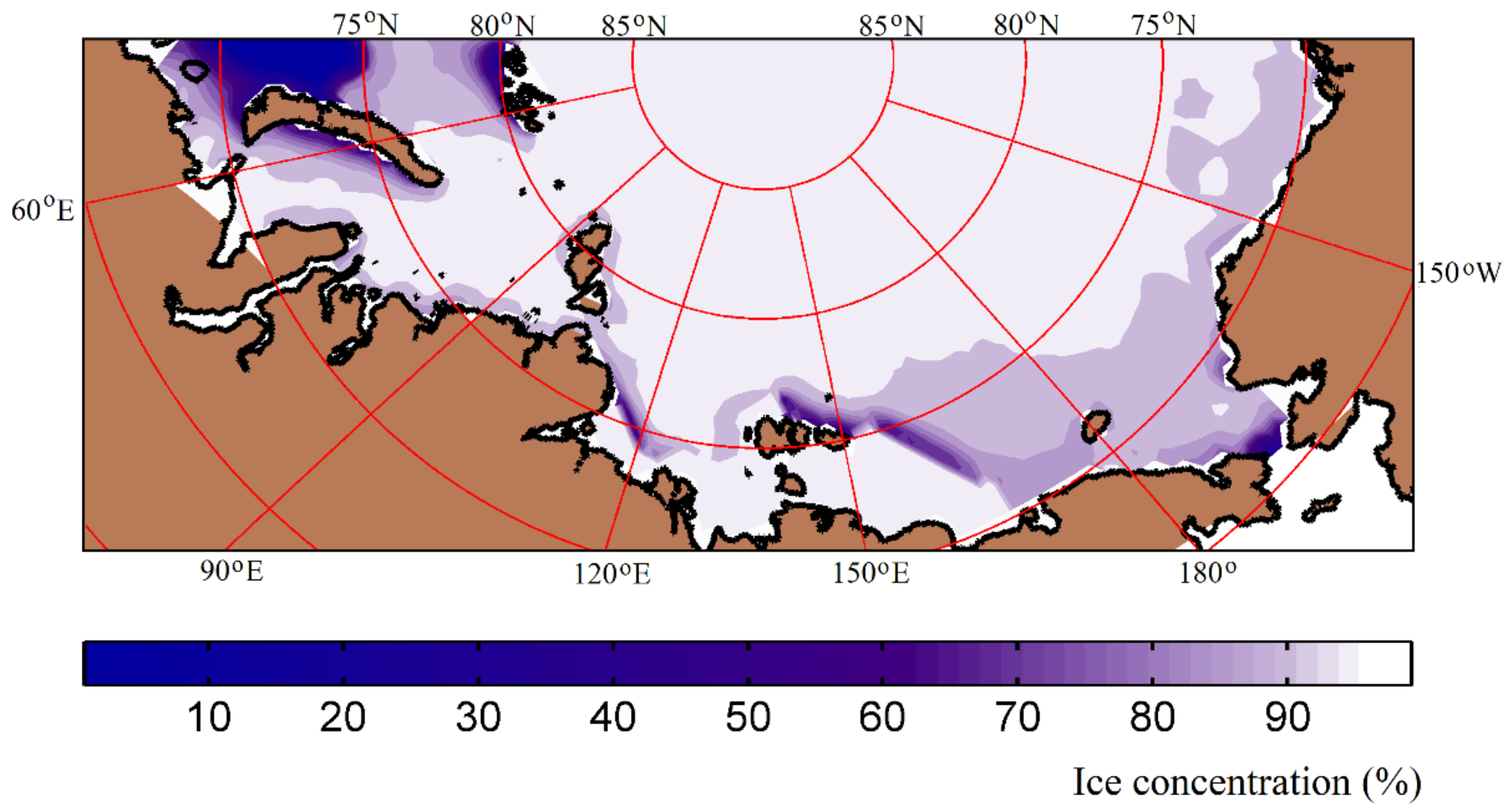
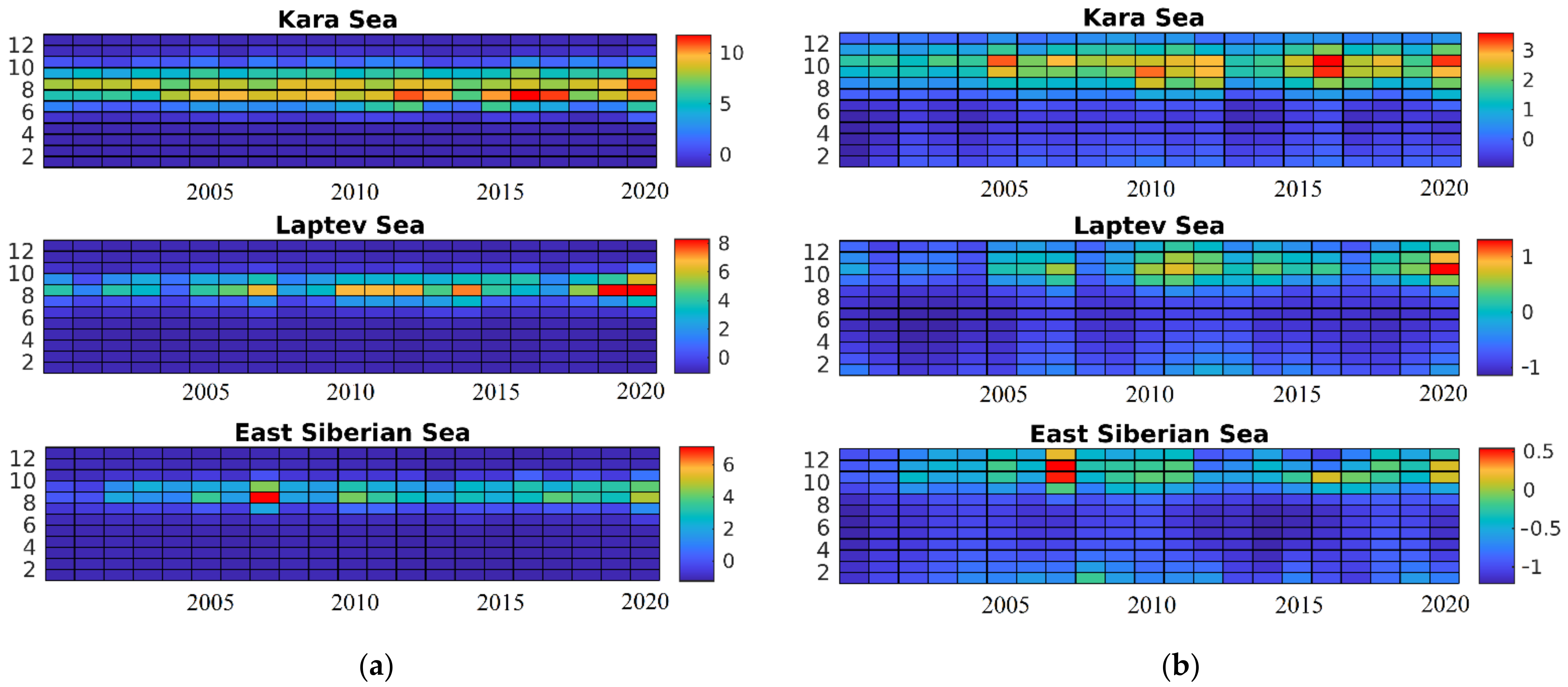
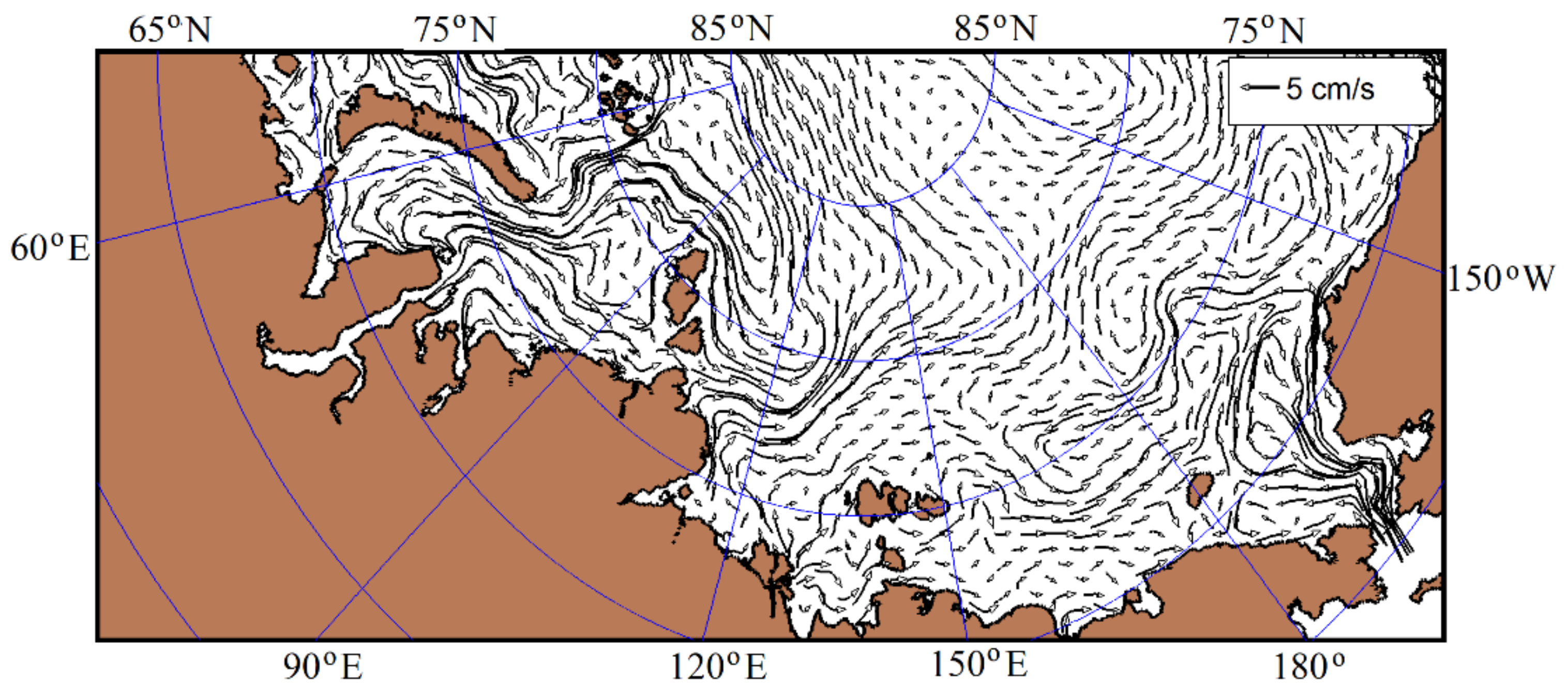
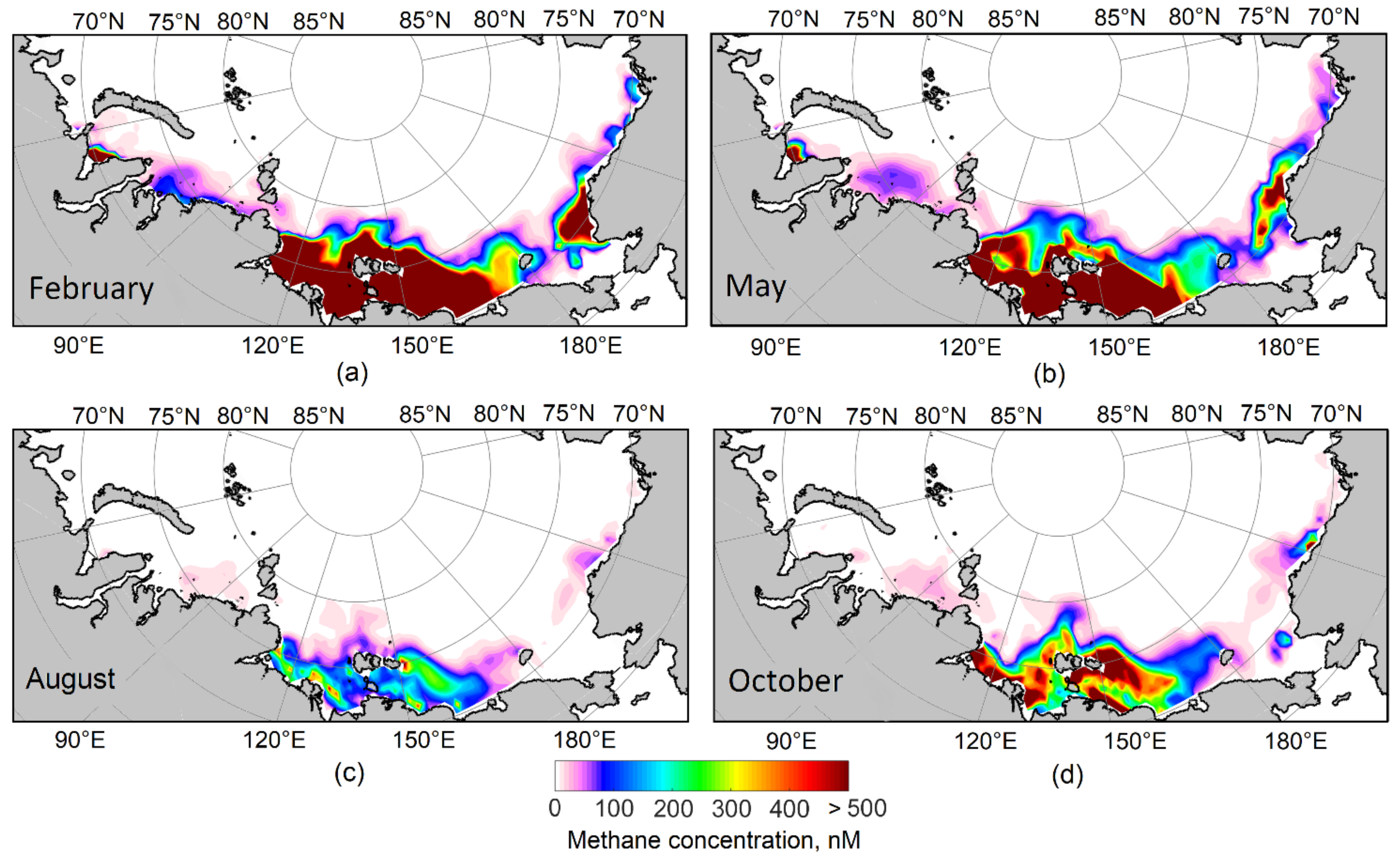

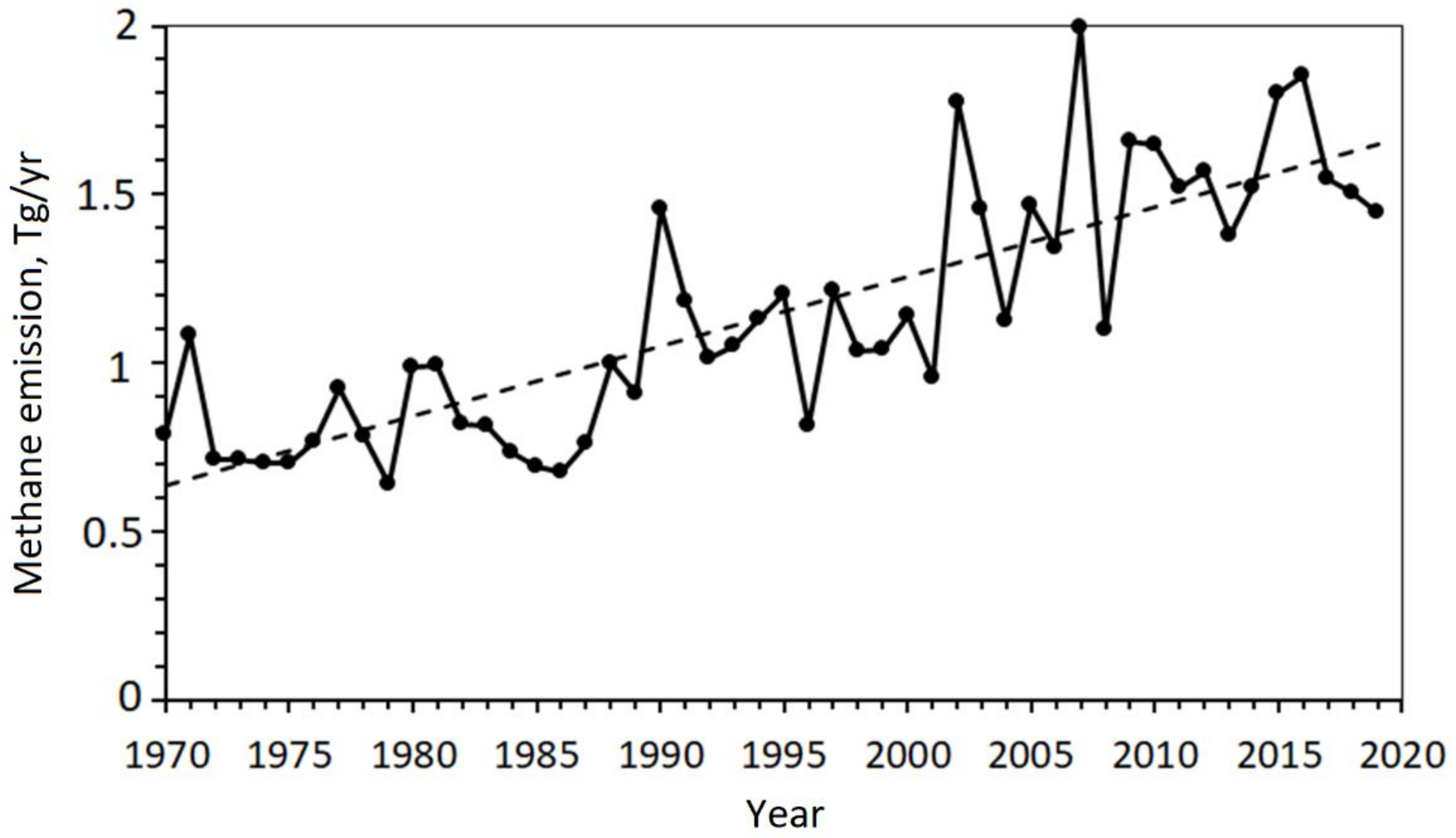
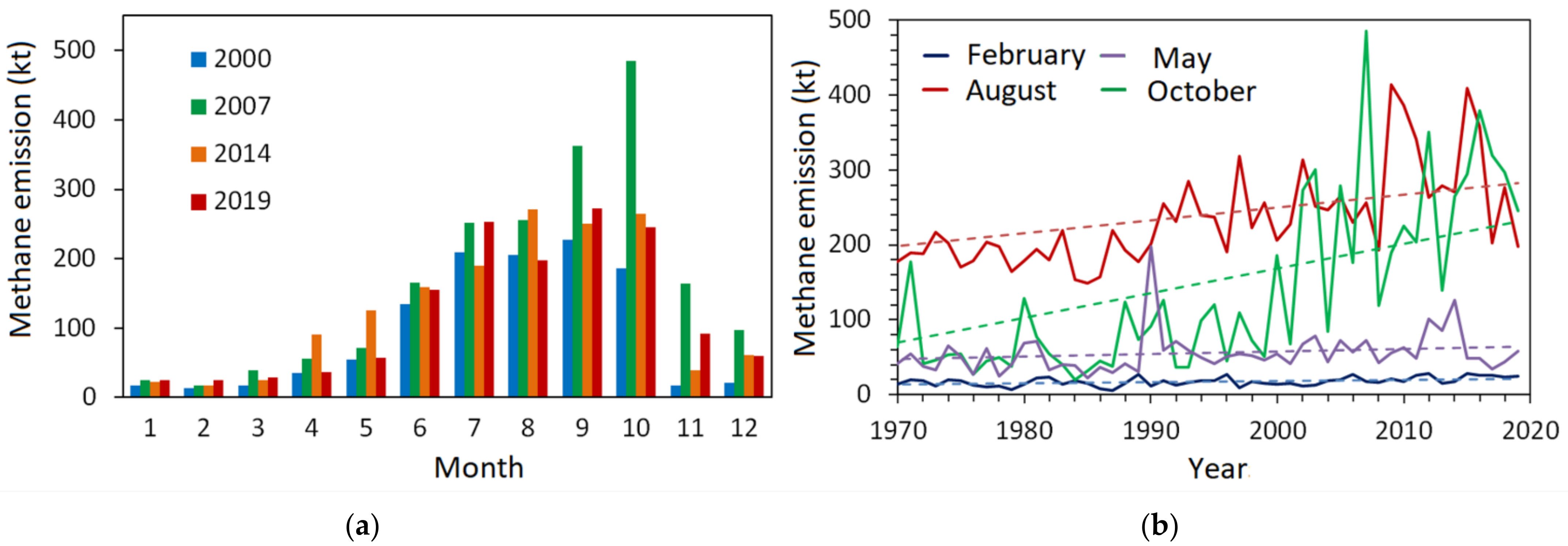
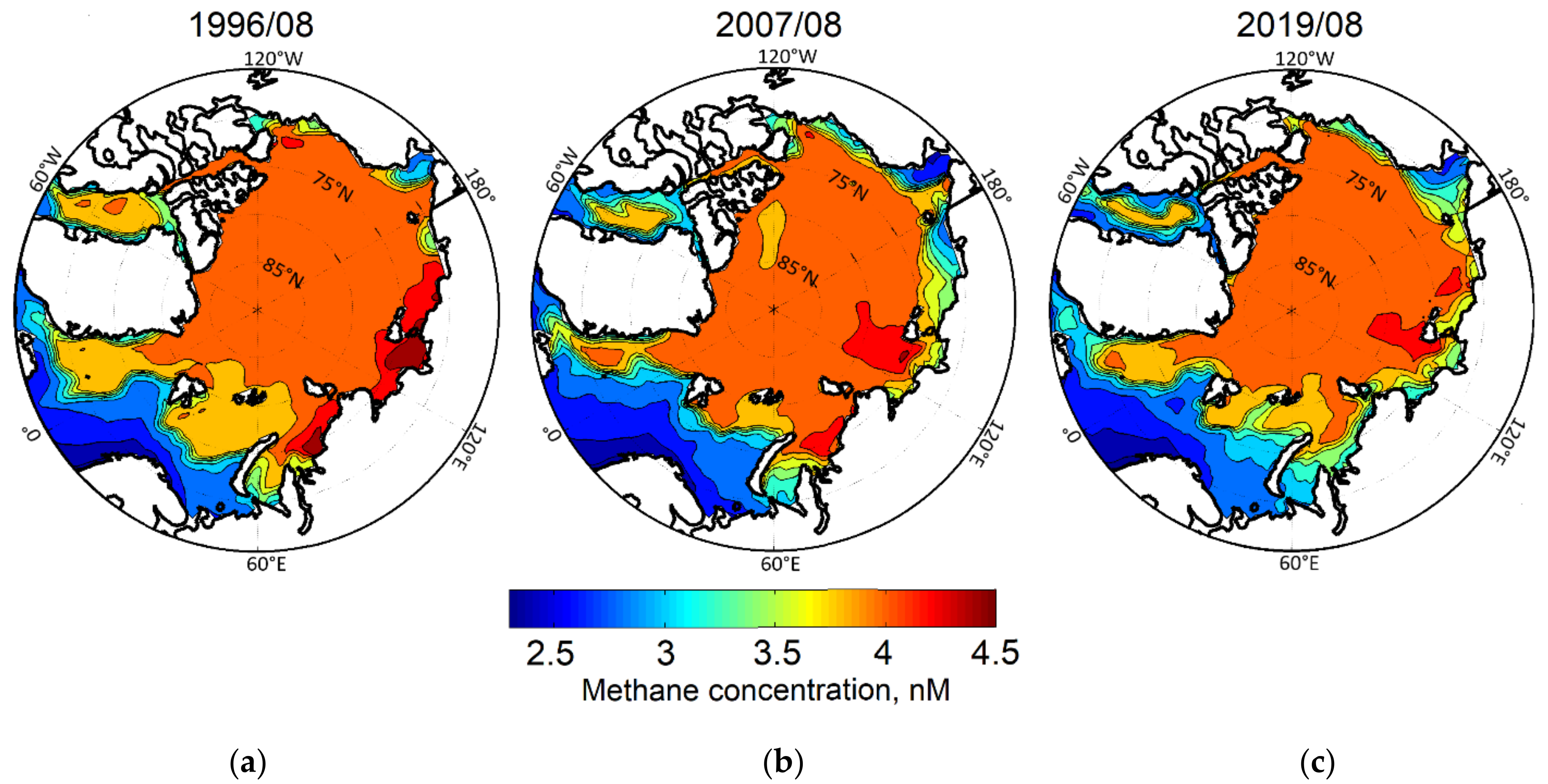

Publisher’s Note: MDPI stays neutral with regard to jurisdictional claims in published maps and institutional affiliations. |
© 2022 by the authors. Licensee MDPI, Basel, Switzerland. This article is an open access article distributed under the terms and conditions of the Creative Commons Attribution (CC BY) license (https://creativecommons.org/licenses/by/4.0/).
Share and Cite
Malakhova, V.; Golubeva, E. Model Study of the Effects of Climate Change on the Methane Emissions on the Arctic Shelves. Atmosphere 2022, 13, 274. https://doi.org/10.3390/atmos13020274
Malakhova V, Golubeva E. Model Study of the Effects of Climate Change on the Methane Emissions on the Arctic Shelves. Atmosphere. 2022; 13(2):274. https://doi.org/10.3390/atmos13020274
Chicago/Turabian StyleMalakhova, Valentina, and Elena Golubeva. 2022. "Model Study of the Effects of Climate Change on the Methane Emissions on the Arctic Shelves" Atmosphere 13, no. 2: 274. https://doi.org/10.3390/atmos13020274
APA StyleMalakhova, V., & Golubeva, E. (2022). Model Study of the Effects of Climate Change on the Methane Emissions on the Arctic Shelves. Atmosphere, 13(2), 274. https://doi.org/10.3390/atmos13020274






